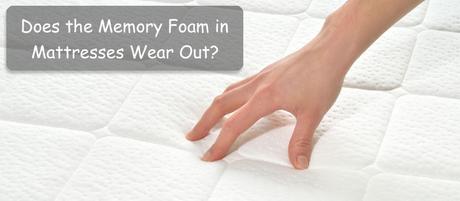Does the memory foam in mattresses wear out? Does your memory foam mattress eventually become unusable because the foam has worn out too much? How long does memory foam last? We have been asked these questions countless times. Here are our answers to these memory foam questions. First, let's consider exactly what memory foam is. It might then be easier to understand the answers.

What is Memory Foam?
Many mattress suppliers refer to memory foam as being manufactured from 'viscoelastic'. This is not technically correct! That is because the term 'viscoelastic' is an adjective describing the way substances react to compression: they display both viscosity (flow) and elasticity (ability to return to its original form). Memory foam is manufactured using a type of polyurethane foam displaying viscoelastic properties. There is no such thing as 'a viscoelastic.'
When it is compressed, both your weight and body heat causes memory foam to flow and conform to your body shape (the 'visco' part). When you move or get out of bed, the 'memory' foam returns to its original shape (usually flat) - this is the 'elastic' part. Many believe elasticity to mean that it can stretch. That is incorrect. Elasticity means that once deformed, the substance can return to its original shape.
How Is Memory Foam Made?
Memory foam is manufactured from a viscoelastic type of polyurethane. When you lie on it, the pressure of your body and your body temperature together softens the foam and makes it almost fluid. It molds around those parts of your body that are most in contact with it. The result of this is excellent support for your pressure points: hips, buttocks, shoulders, elbows, knees and perhaps even your head.
When you move away from that part of the mattress or get up in the morning, its elasticity enables it to revert to its original shape. Check out this short video showing how memory foams work. It shows how the elasticity of memory foam enables it to return to its original shape when deformed. This is what happens when you move to your bed or get up in the morning. Whenever pressure is released, the memory foam will revert to its original smooth form.
The type of viscoelastic foam used to manufacture memory foam mattresses possesses all the properties described above. They are comfortable to lie on, although many people may find them hot during the night. In order to overcome that, some manufacturers introduced a gel into the structure of the mattress. This gets absorbed the heat then rapidly dissipates it, keeping you cool at night.
So: Does Memory Foam Wear Out?
The simple answer to this question is yes: it does wear out. Of course, it does - but when and by how much is the question! Your memory foam mattress may sag or compress too much. Because of the way it works, memory foams can be repeatedly compressed with heat and pressure. Its very nature means that memory foam mattresses compress much faster than a latex or hybrid foam mattress.
How do you minimize the sag or dip in your memory foam mattress? How do you prevent it from compressing to the point that it can no longer recover to its original shape? You cannot prevent it completely, but you can take steps to ensure that the sag in your mattress is reduced to a minimum and that you extend its life by as much as possible. Here's how:
How to Make Your Memory Foam Mattress Last as Long as Possible
Here are some steps you can take to help extend the time it takes for memory foam in mattresses to wear out.
Memory Foam Thickness:
Look on 2 cm thickness of memory foam as being your base figure. This leaves no room for compression. When you lie on a 2 cm thick memory foam mattress, once the foam has compressed to your shape, you have no foam beneath you to hold your weight and provide comfort.
A 2 cm memory foam is unlikely to recover its shape for long. It will quickly take the form of a 2 cm indentation - in other words, create holes in the foam in the shape of your pressure points (shoulders, hips, knees, etc.). Take 5 cm as your minimum memory foam thickness.
Anything over 5 cm will help to extend the life of your mattress. The thicker the foam, the less the memory foam is likely to wear out. As you mattress beds in, you want to have enough foam still available to mold to your body. If not, then your mattress is sure to wear out much quicker.
The more you weigh, the thicker the memory foam layer should be. So a 250 pound person will need a thicker foam than somebody weighing only 110 pounds. The same mattress may suit both but should be specified with the heavier partner in mind.
Use the Entire Mattress
Many people sleep on the same part of the mattress all the time. The result is that part of the mattress will wear out while the rest is in perfect condition. This doesn't mean that you should change your sleeping position, or you and your partner should swap sides now and again. There are other ways of making the best use of the mattress area.
Rotation: Rotate the mattress 180 degrees, so the top is now the bottom. By doing this monthly you will spread wear down the entire length of the mattress. Your upper body will then be supported by the area previously supporting your legs.
If you use a double mattress or wider, you will then use the full width of the mattress: the previous left side is now on the right. If you sleep with a partner, your upper body will now be supported by the part of the memory foam that supported their legs. Rotating a mattress can extend its life significantly. It then takes much longer for the memory foam in mattresses to wear out.
Flipping: If your mattress is double-sided, with memory foam on both the top and the bottom, you can flip it over to use both sides equally. By a combination of flipping and rotation, you can extend the lifetime of a memory foam mattress by years.
Use a Topper: One way of preserving the life of memory foam mattresses is to use a mattress topper. A 2-inch memory foam topper will take a lot of pressure off the main memory foam in the mattress itself. The topper will wear rather than the mattress, and can easily be replaced without the expense of a full mattress. If you use a topper, rotate and flip this the same way as you should with a full mattress.
Does the memory foam in mattresses wear out: Summary
By using a combination of turning and flipping (if possible) you can add years to the life of a memory foam mattress. If you use a topper, and rotate and flip that as well, you can extend its life even more. Other actions you can take to make your memory foam mattress last longer include cleaning. Clean up any spillages and give it a vacuum once a month when you rotate or flip it.
So, does the memory foam in mattresses wear out? Yes, it does. Practically all mattresses will compress and sag over time. Nevertheless, if you take the above steps, you will extend the life of your mattress to a maximum.

